Archive Record
Images
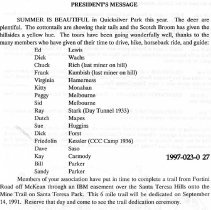
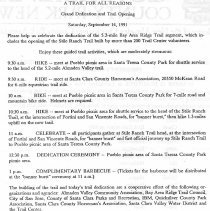




Additional Images [5]
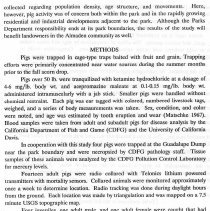
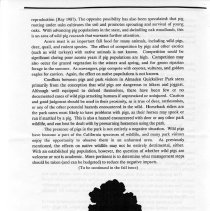

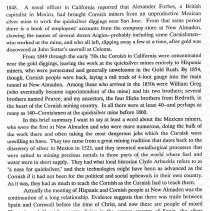
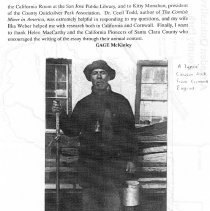
Metadata
Catalog number |
1997.2.2599 |
Object Name |
Newsletter |
Date |
1991 |
Description |
TITLE: Quicksilver County Park News SUBTITLE: Newsletter of the New Almaden Quicksilver County Park Association Issue # 27 Summer 1991 PRESIDENT'S MESSAGE SUMMER IS BEAUTIFUL in Quicksilver Park this year. The deer are plentiful. The cottontails are showing their tails and the Scotch Broom has given the hillsides a yellow hue. The tours have been going wonderfully well, thanks to the many members who have given of their time to drive, hike, horseback ride, and guide: Ed Lewis Dick Wachs Chuck Rich (last miner on hill) Frank Kambish (last miner on hill) Virginia Hamerness Kitty Monahan Peggy Melbourne Sid Melbourne Ray Stark (Day Tunnel 1933) Dutch Mapes Sue Huggins Dick Forst Friedolin Kessler (CCC Camp 1936) Dave Saso Kay Carmody 1997-023-0 27 Bill Parker Sandy Parker Members of your association have put in time to complete a trail from Fortini Road off McKean through an IBM easement over the Santa Teresa Hills onto the Mine Trail on Santa Teresa Park. This 6 mile trail will be dedicated on September 14, 1991. Reserve that day and come to see the trail dedication ceremony. A TRAIL FOR ALL REASONS Grand Dedication and Trail Opening Saturday, September 14, 1991 Please help us celebrate the dedication of the 5.2-mile Bay Area Ridge Trail segment, which in-cludes the opening of the Stile Ranch Trail built by more than 200 Trail Center volunteers. Enjoy these guided trail activities, which are moderately strenuous: 9:30 a.m. HIKE -- meet at Pueblo picnic area in Santa Teresa County Park for shuttle service to the head of the 5.2-mile Almaden Valley trail. 9:30 a.m. RIDE -- meet at Santa Clara County Horseman's Association, 20350 McKean Road for 6-mile equestrian trail ride. 10 a.m. BIKE -- meet at Pueblo picnic area in Santa Teresa County Park for 7-mile road and mountain bike ride. Helmets are required. 10:30 a.m. HIKE -- meet at Pueblo picnic area for shuttle service to the bead of the Stile Ranch Trail, at the intersection of Fortini and San Vincente Roads, for 'banner burst,' then hike 1.3-miles uphill on the new trail. 11 a.m. CELEBRATE -- all participants gather at Stile Ranch Trail head, at the intersection of Fortini and San Vincente Roads, for 'banner burst' and first official journey up Stile Ranch Trail to Pueblo picnic area of Santa Teresa County Park. 12:30 p.m- DEDICATION CEREMONY -- Pueblo picnic area of Santa Teresa County Park picnic area.. 1 P.M. COMPLIMENTARY BARBECUE -- (Tickets for the barbecue will be distributed at the 'banner burst' ceremony at 11 a.m.) The building of the trail and today's trail dedication are a cooperative effort of the following or-ganizations and agencies: Almaden Valley Community Association, Bay Area Ridge Trail Council, City of San Jose, County of Santa Clara Parks and Recr--anon, IBM, Quicksilver County Park Association, Santa Clara County Horseman's Association, Santa Clara Valley Water District and the Trail Center. What We Did Spring brought visitors to the museum and the park, and despite the freeze and drought last winter some plant growth in the park flourished. The scotch broom was particularly abundant and spectacular. The museum was visited by guests from as far away as Florida, New York, and Washington as well as California residents. It is often a revelation for local residents to "discover" New Almaden and learn of the activities which occurred here. In April we welcomed a group from the Trolly Barn of the San Jose Historical Museum, and in July members of the Model A Club of San Jose. In both cases information was exchanged because the activities of the clubs intrigued the Quicksilver guides and the club members were fascinated by the mining at Mine Hill. On May 11 the Quicksilver Runners took over with their 50 mile or 50 kilometer (choose one) race over and around the park. RUN, RUN, run ... And the winners were: Men's 50 Mile - Tom Johnson 7 hr:6 min, Women's 50 Mile run -Lorraine Gersitz 8 hr: 48 min, Men's SOK - Dave Scott 4 hr: 8 min, Women's 50 K -Tracy Achelis 5 hr: 20 min. Members of the Valley Christian School Middle School toured the museum on May 30. Teacher Lyn Lafayette led a group of 38 students on the tour. Then, on June 4, 15 women comprising the Welcome Wagon visited the Museum. The Argonauts, 35 strong toured and lunched in the Park, and visited the Museum on April 13. Hikes through the park were conducted by Kitty Monahan on the 4th and 18th of May. Kitty Monahan organized two very important horse tours. On May 19 a horse tour for the County Parks and Recreation Department, Supervisor Michael Honda and 30 other area equestrians was led by Bill and Sandy Parker. Two months later on July 13, Dutch Mapes led a group of 40 people, six of whom were commissioners of the Santa Clara County Parks and Recreation Commission. The association held work days at the museum on June 1st and 29th. After that the Full Moon Barbecue was an event! It was celebrated nn July 26th. Nine trucks carried 52 people above Deep Gulch in Spanishtown to view the moon rise. And the moon came up on time. Dick Wachs Dates to Remember Saturday, September 14 - Dedication of Stile Ranch Trail Sunday, September 15 - Almaden Valley Women's Club annual Wine and Art Festival in Parma Park. Saturday, September 21 - New Almaden Days Saturday, September 28 - Dedication by the Oregon-California Trails Assn. of a plaque and monument of cinnabar ore at the gravesite of Grove Cook in the Evergreen Cemetery in Santa Cruz. Cook was a member of the Bidwell-Bartleson Party of 1841, the first group of pioneers from the eastern half of the United Stated to cross the Sierras. Grove Cook was the first American to own a portion of the cinnabar mine at New Almaden because of his ownership of the Justo Larios Rancho. In 1848 Thomas O. Larkin and a group of prominent Americans, among them Grove Cook, formed a new mining company eventually known as the Fassat claim. Diseno of I arios Rancho Saturday October 12 - Pioneer Day to be held at the Ameriuin Shaft. From the Record Book of John Atwood The following is another excerpt from the "Record" of John Atwood, an employee of the New Idria Mining and Chemical Company, who worked at the New Almaden Quicksilver Mine from November 1968 until September 1969. "Work began on April Tunnel about October 21, 1968. As of today (November 27, 1968) about 85 feet is timbered. The April Tunnel will someday connect with the 500 level Almaden Shaft. The tunnel is planned as a straight tunnel on a bearing of S240 07' 30"W. At present only one shift is working. The tunnel so far is in serpentine and rather poor ground." "December 2, 1968 Work on the April Tunnel is now on two shifts. Drift still in serpentine." "Feb. 7, 1969 The April Tunnel is now 600 feet, in alta, from Portal:" "Feb 26, 1969 Last night the April Tunnel holed into the 500 southwest cross-cut of the Almaden Shaft. The cross-cut was caved flat. It appears the April Tunnel is about 5 feet low as expected. The Tunnel was to have come in on level when first started but since that time an elevation was figured for Monument "L" (the datum point for all elevations) and the Almaden 500 level figured out 5 feet higher than expected. A more accurate elevation of the 500 level Almaden will be noted later when it is possible to survey it. The April Tunnel will continue straight ahead and hopefully the main southwest 500 level will be open when it is cross cut in another 70 feet:" MOVEMENTS AND POPULATION CHARACTERISTICS OF WILD PIGS IN ALMADEN QUICKSILVER COUN'T'Y PARK by Martha E. Schuss, Seasonal Park Ranger Under the Supervision of: Ben Assenza, Park Manager, Santa Clara County Parks and Recreation Department INTRODUCTION The wild pig (Sus scrota) has been a part of the California fauna since the 1700's (Barrett 1977). Domestic pigs were released or escaped from European settlers, and proliferated in the State's oak woodland habitat. In few areas, however, did these feral hogs reach high enough densities to become a problem or even to warrant much attention. In the 1920's and 1930's pigs with predominantly European wild boar heritage were released in the Carmel Valley area of Monterey County, transplants from a North Carolina hunting venture (Pine and Gerdes 1973). Although the origin of the European stock is not known, it has been surmised to the Hartz Mountains of Germany (Bratton 1977). In the decades following their California release, these European wild boar have interbred with the feral hogs and, with the illicit help of man, have spread throughout the state. Until the 1960's, their presence was acknowledged primarily in Monterey County, but during the last two decades they have been moved into 33 of California's 58 counties (Mansfield 1986). The wild pig has held great appeal for the California hunter, vying with the declining deer populations as the number one big game animal in the state. An estimated 56,447 pigs were killed by hunters in 1986, compared to an estimated 65,484 deer. Although initially enticed by the sport and possible revenue offered by the wild pig, many landowners have come to recognize the problems brought about by this exotic animal. On public and private lands wild pigs have been maligned for their rooting habits, contamination of water sources, disturbance of camping and picnic areas and damage to native flora and fauna (Pine and Gerdes 1973, Bratton 1975, 1977, Barrett and Pine 1980, Singer et al. 1984). In 1978 the Santa Clara County Parks and Recreation Department addressed wild pig management in Grant County Park in the Mount Hamilton Range by initiating a study of pig population dynamics and movements in the park (Schuss 1980). Results of that study have been used to help make management decisions regarding pig problems around the Grant Park campground, visitor's center, and horse stable. Between 1986 and 1988 this investigation was conducted in Almaden Quicksilver County Park. The objectives were to obtain data to deal with anticipated wild pig management problems in the area. Like the Grant Park study, data were collected regarding population density, age structure, and movements. Here, however, pig activity was of concern both within the park and in the rapidly growing residential and industrial developments adjacent to the park. Although the Parks Department responsibility ends at its park boundaries, the results of the study will benefit landowners in the Almaden community as well. METHODS Pigs were trapped in cage-type traps baited with fruit and grain. Trapping efforts were primarily concentrated near water sources during the summer months prior to the fall acorn drop. Pigs over 50 lb. were tranquilized with ketamine hydrochloride at a dosage of 4-6 mg/Ib. body wt. and acepromazine maleate at 0.1-0.15 mg/Ib. body wt. administered intramuscularly with a jab stick. Smaller pigs were handled without chemical restraint. Each pig was ear tagged with colored, numbered livestock tags, weighed, and a series of body measurements was taken. Sex, condition, and color were noted, and age was estimated by tooth eruption and wear (Matschke 1967). Blood samples were taken from adult and sub-adult pigs for disease analysis by the California Department of Fish and Game (CDFG) and the University of California Davis. In cooperation with this study four pigs were trapped at the Guadalupe Dump near the park boundary and were necropsied by CDFG pathology staff. Tissue samples of these animals were analyzed by the CDFG Pollution Control Laboratory for mercury levels. Fourteen adult pigs were radio collared with Telonics lithium powered transmitters with mortality sensors. Collared animals were monitored approximately once a week to determine location. Radio tracking was done during daylight hours from the ground. Each location was made by triangulation and was mapped on a 7.5 minute USGS topographic map. Four juveniles, one adult male, and one adult female were caught that had foxtails in one or both eyes or had eye damage that could be attributed to prior foxtail injury. One adult male had an old abscessed injury in a front leg; no other detectable injuries or disease symptoms were seen. Blood results were negative for Brucella (n=20) and pseudo rabies virus (n=31). Mercury levels from the necropsied pigs were below levels considered toxic or hazardous for human consumption. All muscle samples were below .02 ug/g. The highest level found was one kidney sample with .40 ug/g. These animals were killed at the Guadalupe Dump site and did not have feeding and watering habits representative of pigs foraging exclusively on vegetation in the park. Poor regeneration of oaks in California is a major habitat problem. The effect of pig rooting and acorn consumption has been speculated as detrimental to oak reproduction (Ray 1987). The opposite possibility has also been speculated: that pig rooting under oaks cultivates the soil and promotes sprouting and survival of young oaks. With advancing pig populations in the state, and dwindling oak woodlands, this is an area of wild pig research that warrants further attention. Acorn mast is an important fall food for many animals, including wild pigs, deer, quail, and rodent species. The effect of competition by pigs and other exotics (such as wild turkeys) with native animals is not known. Competition could be significant during poor acorns years if pig populations are high. Competition may also occur for grazed vegetation in the winter and spring, and for green riparian forage in the summer. As scavengers, pigs compete with coyotes, vultures, and golden eagles for carrion. Again, the effect on native populations is not known. Conflicts between pigs and park visitors in Almaden Quicksilver Park stem primarily from the conception that wild pigs are dangerous to hikers and joggers. Although well equipped to defend themselves, there have been few or no documented cases of wild pigs attacking humans if unprovoked or uninjured. Caution and good judgment should be used in their proximity, as is true of deer, rattlesnakes, or any of the other potential hazards encountered in the wild. Horseback riders are the park users most likely to have problems with pigs, as their horses may spook or run if startled by a pig. This is also a hazard encountered with deer or any other park wildlife, and can best be dealt with by pre-warning horsemen using the park. The presence of pigs in the park is not entirely a negative situation. Wild pigs have become a part of the California spectrum of wildlife, and many park visitors enjoy the opportunity to observe them in an unhunted area. As previously mentioned, the effects on native wildlife may not be entirely detrimental, either. With an established pig population, however, the question of whether wild pigs are welcome or not is academic. More pertinent is to determine what management steps should be taken (and can be budgeted) to reduce the negative impacts. (To be continued in the fall issue) Summary of the Award-Winning Essay "The First Cornish Miner at New Ahnaden" (Editor's note: Gage McKinney's essay on the quicksilver mine during the Anglo-Mexican period is the 1991 $500 first prize winner in the annual Santa Clara County Historical Essay Contest sponsored by the California Pioneers of Santa Clark County). If you visit Cornwall, England's most southwestern county, you can hike up to Carn Brea, a granite medieval castle that perches on a 600 foot hill. From that modest vantage point you can look out over the rolling countryside where Cornish people dug for tin and copper for a thousand years; and on slopes that today are given over to pasture you can see the old brick pump houses of the long-closed mines. To the north on a clear day you might see the Celtic sea breaking near the bluffs; and to the south, where you can't see because of a line of wooded hills, is the picturesque city of Falmouth, the port of embarkation for so many of the hard-rock miners who let England behind when they sailed for America. How small Carn Brea Hill must have seemed in the memory of the first Cornishmen who came to this valley and lifted up their eyes to the 3800-foot Peak of Loma Prieta. My essay, "The First Cornish Miners At New Almaden, " tells a story about these first people who came from Cornwall to Santa Clara County to work in the mines at a time when quicksilver (mercury) was an essential ingredient in the amalgamation of precious metals, including gold. The published literature on New Almaden emphasizes the Cornish miners who came after an American company took control of the mines in 1864, and especially after the arrival of James Randol, the very capable manager who directed the operation during its most prominent years in the 1870s and 80s. But what interested me were the miners who came years before that, during the Anglo-Mexican period (about 1847 to 1863) when the mines were controlled by capitalists from Britain and Mexico. What is special about the Cornish is something more than the fact that they represented an English county that is roughly the same size as our own, or that they brought with them recipes for pasties and clotted cream, or that their culture shows a particular keenness for male choirs and brass bands. What the Cornish represent most was technology. They were simply the most sophisticated miners in the world, having solved all the practical problems of blasting, timbering, hoisting, flooding and ventilating generations before they came to California. They were also the people who developed the most efficient steam engines and who applied them to mines, as well as to railroad and even horseless carriages. What the integrated circuits is to our day, the steam engine was to theirs, and they brought their Cornish engines to all the mining districts of the United States, Mexico and the rest of the world. The first account of Cornishmen at New Almaden comes from late 1847 or 1848. A naval officer in California reported that Alexander Forbes, a British capitalist in Mexico, had brought Cornish miners from an unproductive Mexican silver mine to work the quicksilver diggings near San Jose. From that same period there is a book of employees' accounts from the company store at New Almaden, showing the names of several dozen Anglos--probably including some Cornishmen--who worked at the mine; and who all left, slipping away a few at a time, after gold was discovered at John Sutter's sawmill at Coloma. From 1849 through the early '50s the Cornish in California were concentrated near the gold diggings, leaving the work at the quicksilver mines entirely to Hispanic miners, who were persecuted and generally unwelcome in the Gold Rush. By 1854, though, Cornish people were back, laying a rail track of 4-foot gauge into the main tunnel at New Almaden. Among those who arrived in the 1850s were William Greg (who eventually became superintendent of the mine) and his two brothers; several brothers named Pearce; and my ancestors, the four Hicks brothers from Redruth, in the heart of the Cornish mining country. In all there were at least 40--and perhaps as many as 140--Cornishmen at the quicksilver mine before 1860. In this brief summary I want to say at least a word about the Mexican miners, who were the first at New Almaden and who were more numerous, doing the bulk of the work there and often taking the most dangerous jobs which the Cornish were unwilling to have. They too came from a great mining tradition that dates back to the discovery of silver in Mexico in 1521, and they invented metallurgical processes that were suited to mining precious metals in those parts of the world where fuel and water were in short supply. They had what local historian Clyde Arbuckle refers to as "a nose for quicksilver," and their technologies might have been as advanced as the Cornish if it had not been for the political and social upheavals in their own country. As it was, they had as much to teach the Cornish as the Cornish had to teach them. Actually the meeting of Hispanic and Cornish people at New Almaden was the continuation of a long relationship. Evidence suggests that there was trade between Spain and Cornwall before the time of Christ, and now there are people of mixed Hispanic and Cornish ancestry living in the copper country of Spain, the silver districts of Mexico and in the Santa Clara Valley. In our own county Hicks Road, which runs the length of Guadalupe Canyon near the County Quicksilver Park, is named for the Cornish miner Thomas Hicks and his native Californian wife, Josefa Bernal Hicks, a descendant of some of our earliest Hispanic settlers. If you have attended recent Pioneer Days you may have met living evidence of the relationship between Cornish and Hispanic culture in the person of Sylvia Miller of San Francisco. She was born on Mine Hill at New Almaden and was taken to Mexico as a child where her father, James Climo, a miner from St. Austell, Cornwall, was working in a copper mine. For helping with my research I am indebted to George Kobayashi, curator the California Room at the San Jose Public Library, and to Kitty Monahan, president of the County Quicksilver Park Association. Dr. Cecil Todd, author of the Cornish Miner in America, was extremely helpful in responding to my questions, and my wife Ilka Weber helped me with research both in California and Cornwall. Finally, I want to thank Helen MacCarthy and the California Pioneers of Santa Clara County who encouraged the writing of the essay through their annual contest. Gage McKinley |
People |
Assenza, Ben Atwood, John Carmody, Kay Forst, Dick Hammerness, Virginia Giannini Higgins, Sue Kambish, Frank A. Kessler, Friedolin Lewis, Ed Mapes, Dutch (Warren J.) Melbourne, Peggy Melbourne, Sid Monahan, Kitty Parker, Bill Parker, Sandy Rich, Chuck Saso, Dave Schauss, Martha Stark, Ray Wachs, Richard |
Cataloged by |
Meyer, Bob |
